How much electricity does an air purifier use? This is an important question for homeowners looking to improve their indoor air quality efficiently. As these units are becoming common, understanding their energy consumption is necessary. Let’s discover what wattage a purifier uses and compare this with other appliances for better understanding!
Quick Answer
To quickly answer your question, the electricity cost of a purifier depends on many factors, such as:
- Power usage;
- Duration of use;
- Price of the electricity;
- Type of the filter.
However, that’s just the tip of the iceberg. Continue reading as I’ll discuss in detail how different types of purifiers use electricity. Plus, there will be a comparison of different appliances in terms of electricity consumption. Stay with me till the end to learn how to choose and keep your purifier’s bill in the budget. Let’s explore this informative guide in detail!
How Much Electricity Does an Air Purifier Use? An Insight Into Air Purifier Consumption
Most HEPA purifiers only use around 20 watts at level 3 and 50 watts on turbo. But what if you only require it to run for custom hours – let’s say for 8 hours? In this scenario, how much power will it use?
For this, you apply this formula: Watts (W) x Hours in Operation.

Let’s take a look at one example to understand this:
A 50W purifier, operating for 8 hours daily, will consume [50 (watts) x 8 (hours used)] 400 Watt-hours of electricity.
Comparative Electricity Consumption Among Household Appliances
The following are some factors that can be used to compare the electricity consumption of a purifier with different household appliances:
Wattage
In the given table, we’ll have a look at the power usage of various devices to know how purifier stands against them in terms of wattage:
Appliance | Energy Consumption |
Air purifier: | 8 – 56 Watts |
Refrigerator: | 350 – 780 Watts |
LED TV: | 30 -100 Watts |
Microwave Oven: | 800 Watts |
Incandescent Light Bulb: | 60 Watts |
Laptop: | 65 Watts |
As shown, compared to most other home equipment, the purifier does not use much electricity. You can even operate it for most hours of the day without concern about electricity costs.
Dollar Value
No doubt, the wattage is a useful determinant. But the electricity bill would provide a more precise comparison when you have to look at the consumption cost of different devices. Here, I’ll transform watts to kilowatt hours, the standard electricity billing unit, to simplify the process.
In the U.S., the price per kilowatt hour can vary by census division and state. For ease of calculation, I will assume an average cost of electricity across average value for all sectors and states of 13 cents.
Appliance | Power (Watts) | Daily Usage (Hours) | Monthly Energy Consumption (kWh) | Yearly Energy Consumption (kWh) | Monthly Cost (USD) | Yearly Cost (USD) |
Air purifier: | 56 | 8 | 13.44 | 161.28 | 1.75 | 20.97 |
Fridge: | 780 | 8 | 187.2 | 2246.4 | 24.34 | 292.03 |
LED TV: | 100 | 8 | 24 | 288 | 3.12 | 37.44 |
Microwave Oven: | 800 | 8 | 192 | 2304 | 24.96 | 299.52 |
Light Bulb: | 60 | 8 | 14.4 | 172.8 | 1.87 | 2.46 |
Laptop: | 65 | 8 | 15.6 | 187.2 | 2.03 | 24.34 |
The calculations given in the above table are based on the fact that the purifier is on its low and max settings. Therefore, it’s a rough estimate, and the actual cost of how much electricity a purifier will use may vary.
Operating Costs for Continuous Usage of An Air Purifier
Wattage identifies the electricity an average air purifier needs, meaning higher-wattage purifiers are more expensive. With that, your air purifier’s estimated monthly operating costs could range from $4 to $20.
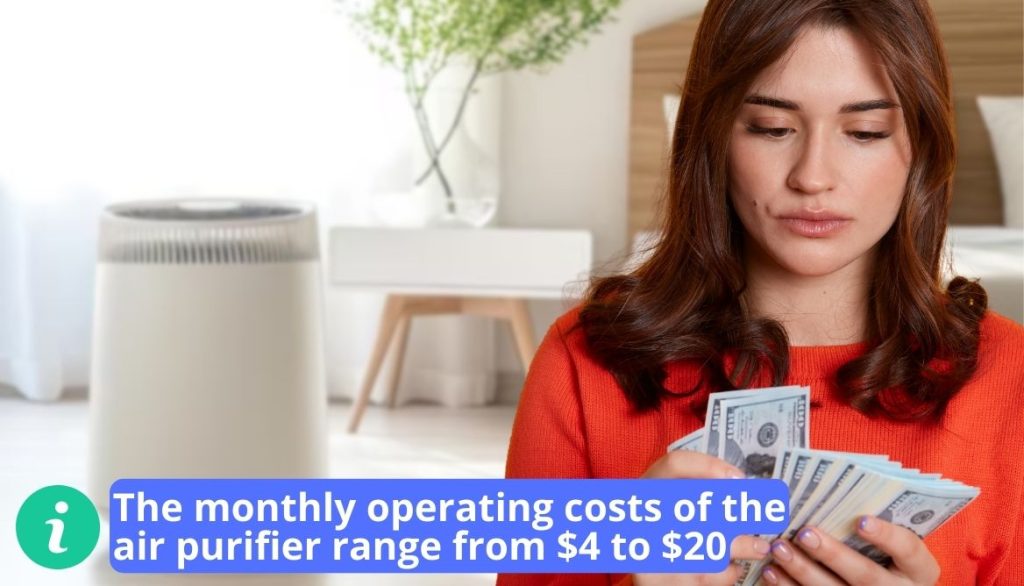
So, let’s take the device’s wattage, the amount of time used, and the local power rate of a 56W purifier to calculate the cost of running a purifier all day.
Fan Speed | Hours Used Each Day | Daily Cost | Monthly Cost | Annual Cost |
Low | 24 | $0.161 | $4.83 | $58.87 |
Medium | 24 | $0.317 | $9.51 | $117.67 |
High | 24 | $0.645 | $19.35 | $236.27 |
If your air purifier has a different wattage, you might need to calculate it again with the following formula:
Cost = (Wattage / 1000) x Hours Used per Day x Electricity Rate
Energy Consumption Purpose of Purifier
Now, after going through all the costs, you must wonder why the purifier needs electricity. Then, your answer lies in the fan. An average air purifier fan draws air from the room into the filter, cleans it, and then sends it again to your room.

There is a small motor to run a fan to carry out the whole process, using all the electricity. Besides this, the smaller electronic parts of the unit also need a tiny amount of electricity. These include elements like:
- Sensors;
- Buttons;
- Interfaces with Wi-Fi;
- Bluetooth functionality.
Read Also: Do Air Purifiers Give Off Radiation? 3 Important Things
Impact of Air Purifier Fan Speeds on Power Usage
Another major factor affecting electricity consumption is the fan speed setting of an air purifier. Here’s how the fan speed can impact electricity consumption.

- Low Speed: It uses the least electricity around 8W and is particularly suitable for silent operation at night.
- Medium Speed: The power consumption at this setting is moderate between the purifier’s wattage range of around 30W. It is excellent for daytime use when there are pollutants in the air.
- High Speed: It takes 50-60W electricity. It is useful when you need speedy air cleaning, such as after cooking.
Air Purifiers and Their Energy Star Certification
To determine whether or not a device is sufficiently efficient, the United States administration instituted a program entitled Energy Star. It is an additional method to guarantee that your purifier is efficient. Certain brands have attained this endorsement. Let’s head toward the next section and learn more about them.
Power Consumption Explained Of Different Brands
Here’s a quick overview of how much electricity the energy-efficient air purifiers will consume:
1. LEVOIT
Most air purifier models only utilize 15-55 watts. This signifies that operating them for 12 hours daily will cost you $0.7 – 2.57 monthly.
2. Medify
The maximum power consumption for Medify purifiers falls in the range of 18 – 95 Watts. Utilizing it for 12 hours will bill you around 80 cents and $4.4
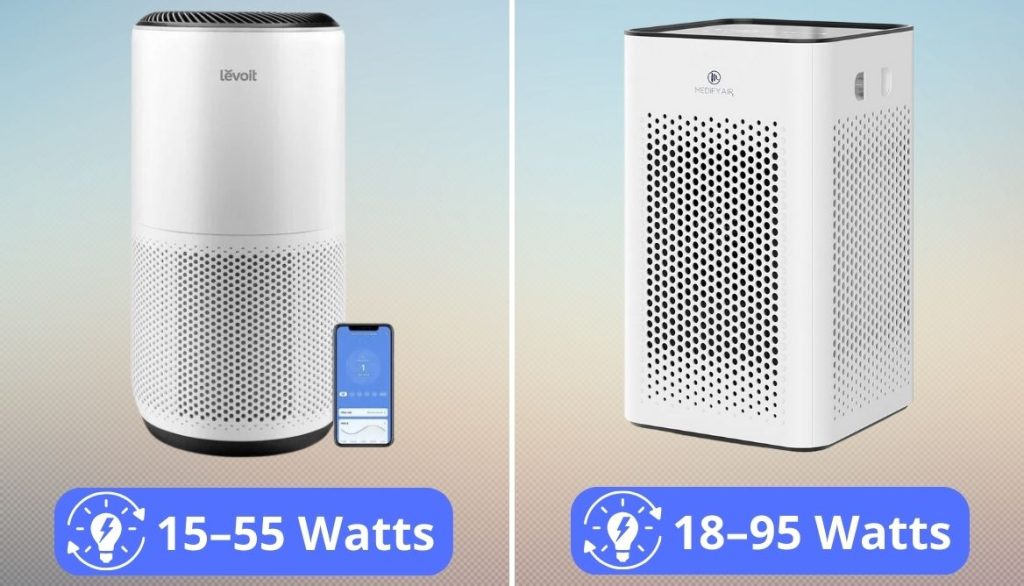
Read Also: Best Air Purifier For 1500 Sq Ft: 5 Great Models of 2025
3. Winix
Winix purifiers come with 55-90 wattage, and running them 12 hours a day will give you a bill between $2.40-$3.90 monthly.
4. Okaysou
Okaysou models also come with low wattage that ranges from 24-50 Watts. Hence, they will only cost you 1.1 and 2.2 dollars monthly if used daily.
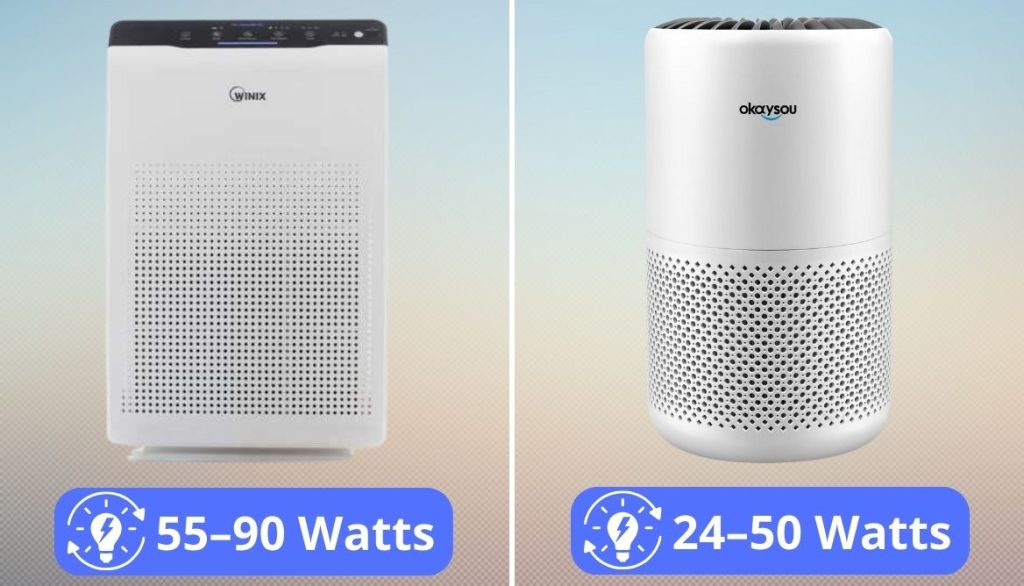
5. Austin Air
The wattage of Austin purifiers is pretty high, varying from 132–135 watts. Due to this reason, these air purifiers use more electricity than usual. Therefore, if operated daily, you’ll expend between $5.7 and $5.8 a month in terms of bills.
6. Alen
Finally, Alen is another brand whose purifiers use 45 to 105 watts of power at maximum speed. Consequently, if utilized for 12/7, the monthly electricity cost will be between $2 and $5.
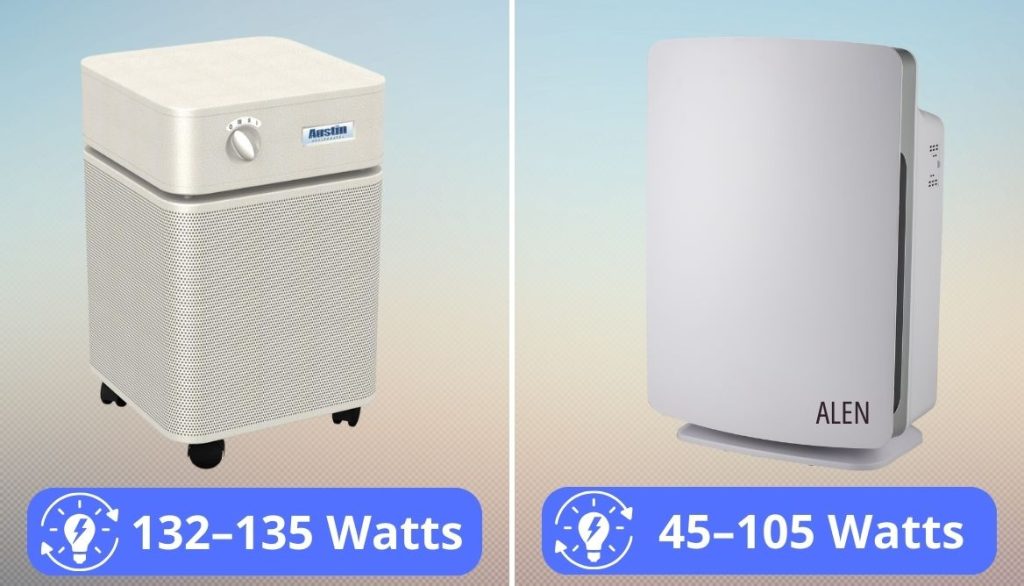
Power Consumption of Large Room Air Purifiers
Purifiers for spacious rooms utilize the most electricity. They are engineered to effectively clean the air in larger areas, frequently covering over 400 square feet.
One illustration is the Honeywell HPA300. It comes with a high cleaning power that has a CADR (Clean Air Delivery Rate) of more than 300.
This is how much electricity it consumes:
- Low Fan Speed: Usually consumes around 40-50W.
- Medium Fan Speed: Generally utilizes about 80-90W.
- High Fan Speed: Uses approximately 130W when functioning at maximum power.
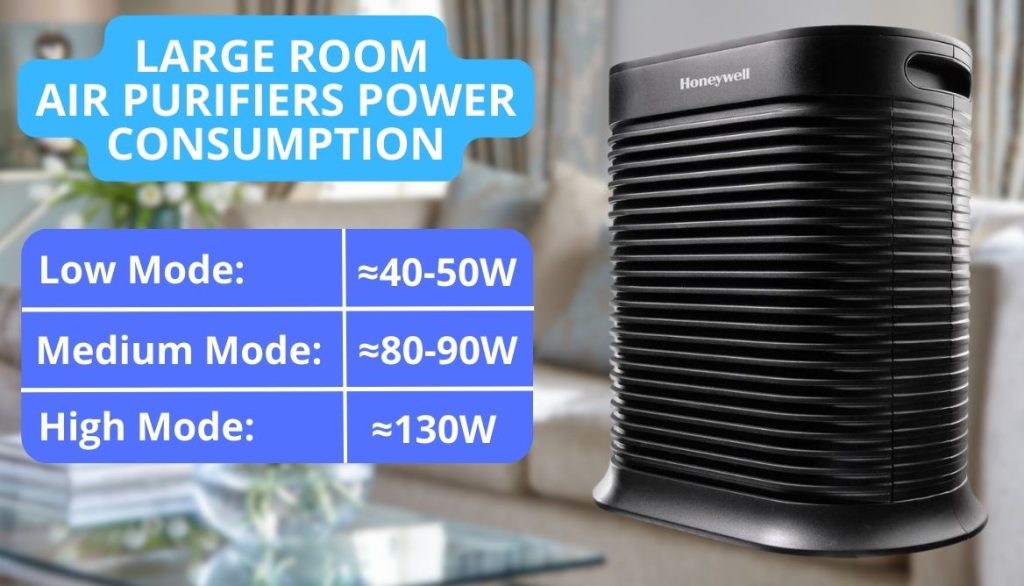
Power Consumption of Mid-Sized Room Purifier
Mid-sized air purifiers offer an equilibrium between room coverage and energy consumption. Let me explain with an example. This is the HathaSpace HSP001 a prevalent mid-size purifier, and below are the details of how much energy it uses:
- Low Fan Speed: Usually utilizes around 22W.
- Medium Fan Speed: Generally consumes approximately 30W.
- High Fan Speed: Expends about 40W when operating at maximum power.

Power Consumption of Small Room Air Purifiers
When it comes to the small rooms with an area of 100 to 200 square feet, the stats for energy utilization of air purifiers are different. The Levoit 132H, a popular small-room air purifier consumes:
- Low Fan Speed consumption is around 8W.
- Medium Fan Speed utilization is approximately 18W.
- High Fan Speed costs about 28W.

Optimizing Air Purifier Efficiency: Best Practices
Listed below are the best recommendations to optimize your purifier’s performance. Let’s check them out:
1. Routine Pre-Filter Maintenance
The first thing you need to look for is regularly clean your pre-filter. Since the air purifier works by capturing large particles like hair, fur, and lint, cleaning it every two weeks is advisable to ensure efficient air purification.
2. Utilizing Auto Mode and Sensor Cleaning
Next, you must use auto mode with air quality sensors to adjust the fan speed automatically. These sensors continuously check air quality in the room, reduce fan speed, and increase energy efficiency.
3. Optimal Placement for Efficient Airflow
Moreover, position the air purifier in the central location to get the most out of it. This way, the device can quickly and thoroughly clean the air by drawing in air from all corners of the room.

Read Also: Can Air Purifiers Make You Sick? 3 Dangers They Can Pose
4. Enhancing Efficiency by Sealing Doors and Windows
Instead of generating fresh air, most purifiers clean and circulate the air already present in your space. So, to run it efficiently, close the doors and windows to enhance the indoor atmosphere significantly.
This stops the entry of fresh pollutants, enabling the air purifier to concentrate on purifying the current air.
6 Factors Influencing Energy Use and Your Electricity Bill
Here are some key aspects to ponder regarding air purifiers’ power usage:

- Area Covered: The space the air purifier can treat determines its electricity needs. Models for larger rooms may need more power than those for smaller spaces.
- Usage Time: The energy required by air purifiers is proportional to the operating time. Continuous use leads to higher costs versus intermittent operation.
- Filter Type and State: Purifiers use different filters such as HEPA and activated carbon. The filter’s design and current state also influence energy usage. Similarly, clogged filters force the air purifier to work harder, which can also increase power consumption.
- Air Quality: Dirty and humid air requires more effectiveness from the air purifier. Thus, a regular check on the air quality can reduce the burden on the purifier.
- Wattage: The energy consumption of an air purifier depends on its size and features. usually, a smaller unit takes less power and vice versa. An average purifier consumes around 50 watts.
- Efficiency: Some models have energy-efficient features like variable speeds and timers to manage consumption.
Crucial Highlights of Energy Efficient Air Purifier
Listed below are the important takeaways for an energy-efficient air purifier:
- The purifiers can cost you about $20 monthly if you use them continuously.
- It is worth noting that these devices use way less power compared to other household electronics.
- Various air purifier brands and models have numerous wattage and energy draws.
- This formula shows amount of the electricity does an air purifier use: Watts x Operating Hours.
For further info, check out this helpful video :
Read Also: Negative Side Effects of Air Purifiers: 3 Important Points
Important Considerations Before Buying An Air Purifier
While going to buy an air purifier, keep in mind the following points:
- Room Size: Examine the room’s space. Selecting an air purifier with an appropriate size for the space is vital for optimal performance.
- CADR Rating: Examine the CADR score, which measures how quickly the air purifier eliminates airborne contaminants. Higher CADR indicates better purification.
- Convenience Features: Consider the availability of remote control, adjustable speeds, sensors, and timer. These can increase practicality and ease of use.
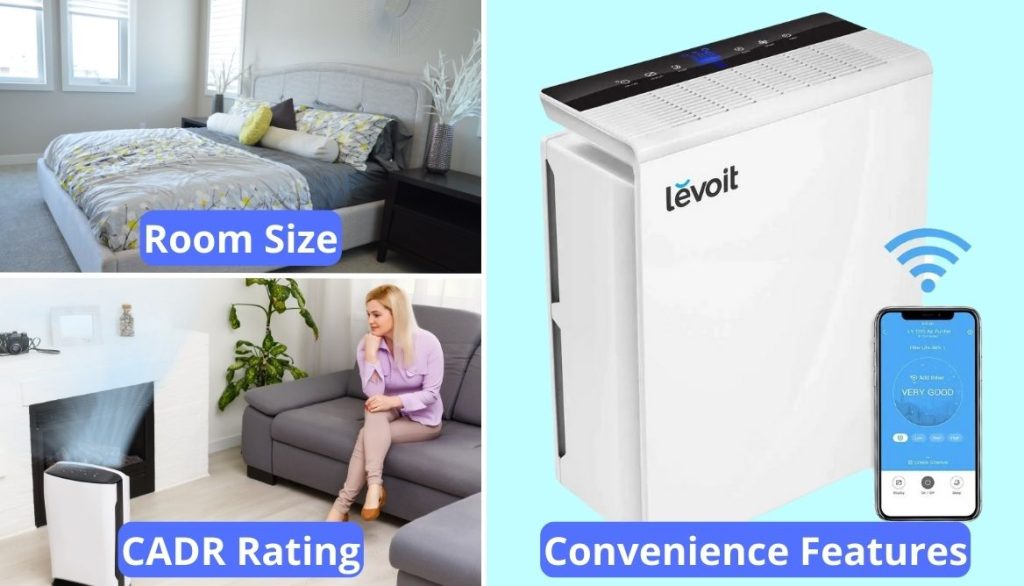
What Makes A Purifier a Preferable Choice!
When it comes to air purifiers, not all models are created equal. There are several key factors that distinguish a high-quality, efficient air purifier:
- Powerful fan for strong air circulation;
- Large coverage capacity for spaces up to 500 sq ft;
- Built-in sensors to monitor air quality;
- Smart features like auto mode and timing settings;
- Quiet operation at low noise levels;
- Durable construction with a long filter life.
FAQs
Do purifiers use a lot of electricity?
No, air purifiers don’t use a lot of electricity. Most air purifier’s energy consumption is less than 100W, which means less power consumption. Roughly, if you run a 50 W air purifier for a day daily, it will cost you a few bucks monthly.
Does using auto mode save energy?
Yes, at some point devices on auto mode save more energy. That’s because when the auto mode is turned on, the air purifier will adjust according to the room’s air quality. This way, the device sometimes will run in the lowest setting and thus save energy.
Are air purifiers energy-efficient?
Yes, compared to other home appliances, most air purifiers are very energy-efficient. In fact, they use 2-3 times less electricity overall, even if you run it at full setting.
Conclusion
Summing up how much electric does an air purifier use depends upon various factors like usage time, condition of filters, and wattage consumption of the purifier. On average, a 50W purifier that operates for 8 hours will cost around $20 annually. If you run the purifier 24/7 on medium speed then your bill can jump up to more than $100/year. It is recommended that you buy a purifier that is Energy-Star certified such as Levoit.
Proper maintenance and tuning can decrease the overall bill. Finally, keep an eye on the strategic placement of air purifiers, filter conditions, and indoor air quality so that you can get the most out of your air purifier without getting high bills!

Danny is a passionate writer who loves to share his knowledge about air purifiers. He’s been writing for 10 years, and he’ll share all that experience with Very Well Home viewers to help you make the best decision when it’s time to buy an appliance!






![Best Air Purifier for Car in [y] - Reviews and Buying Guide Best Air Purifier for Car](https://verywellhome.com/wp-content/uploads/2022/01/www.verywellhom.com-10-150x150.jpg)
